Analysis of Social Determinants of Health for Aboriginal Australians
VerifiedAdded on 2021/04/21
|10
|2022
|69
Report
AI Summary
This report analyzes the social determinants of health from the perspective of Australian Aboriginals, providing an overview of their health status and patterns of heart disease. It explores the influence of socioeconomic factors, social exclusion, and other determinants on morbidity and mortality rates within this population. The report also examines public health interventions, including community programs and educational initiatives, to address the social gradient of health and improve access to healthcare. Furthermore, it highlights the roles various sectors, beyond the health sector, can play in promoting health equality. The report concludes with a summary of key findings and suggestions for further research, offering a comprehensive perspective on the challenges and potential solutions related to Aboriginal health in Australia. The report is available on Desklib, a platform providing AI-based study tools for students.
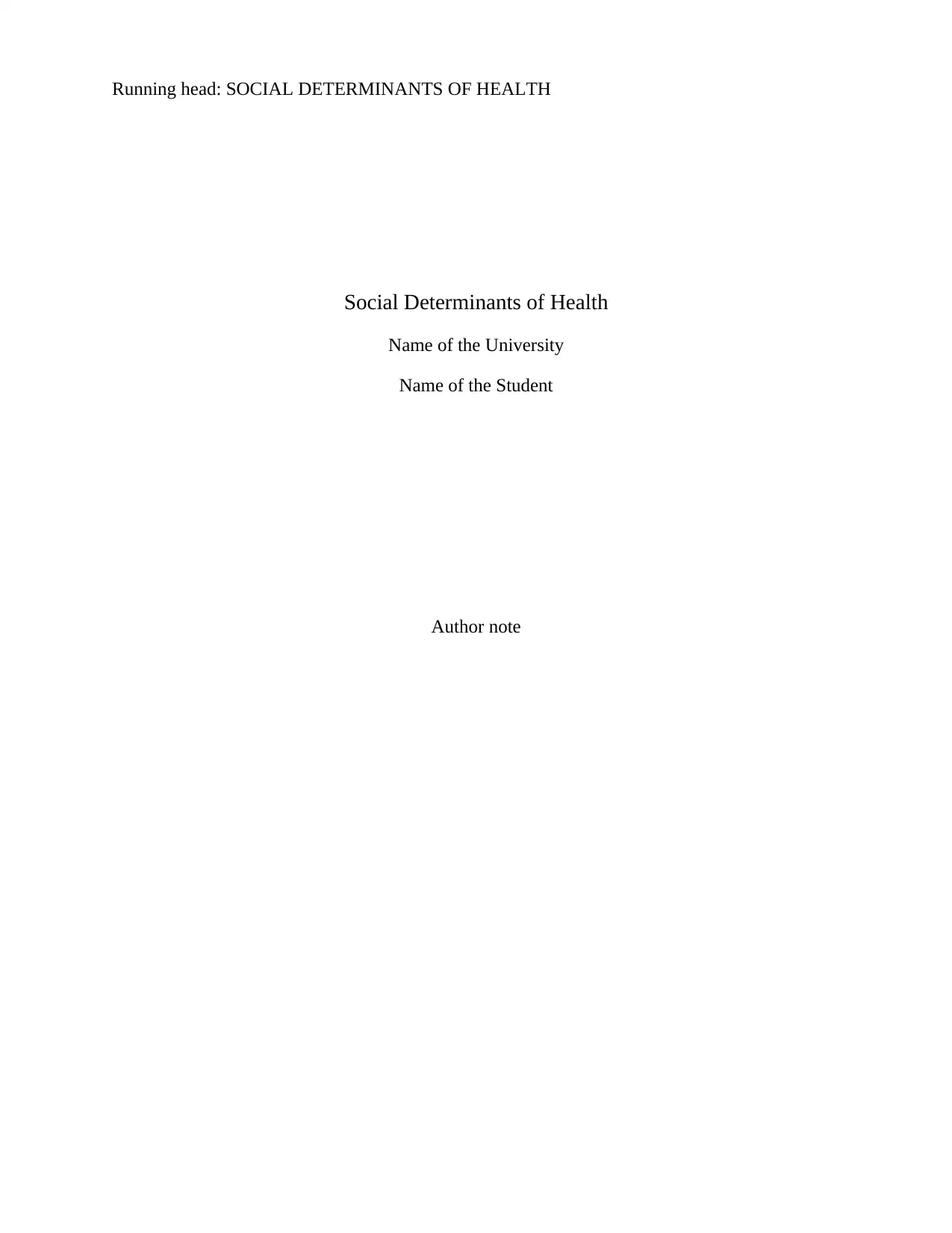
Running head: SOCIAL DETERMINANTS OF HEALTH
Social Determinants of Health
Name of the University
Name of the Student
Author note
Social Determinants of Health
Name of the University
Name of the Student
Author note
Paraphrase This Document
Need a fresh take? Get an instant paraphrase of this document with our AI Paraphraser
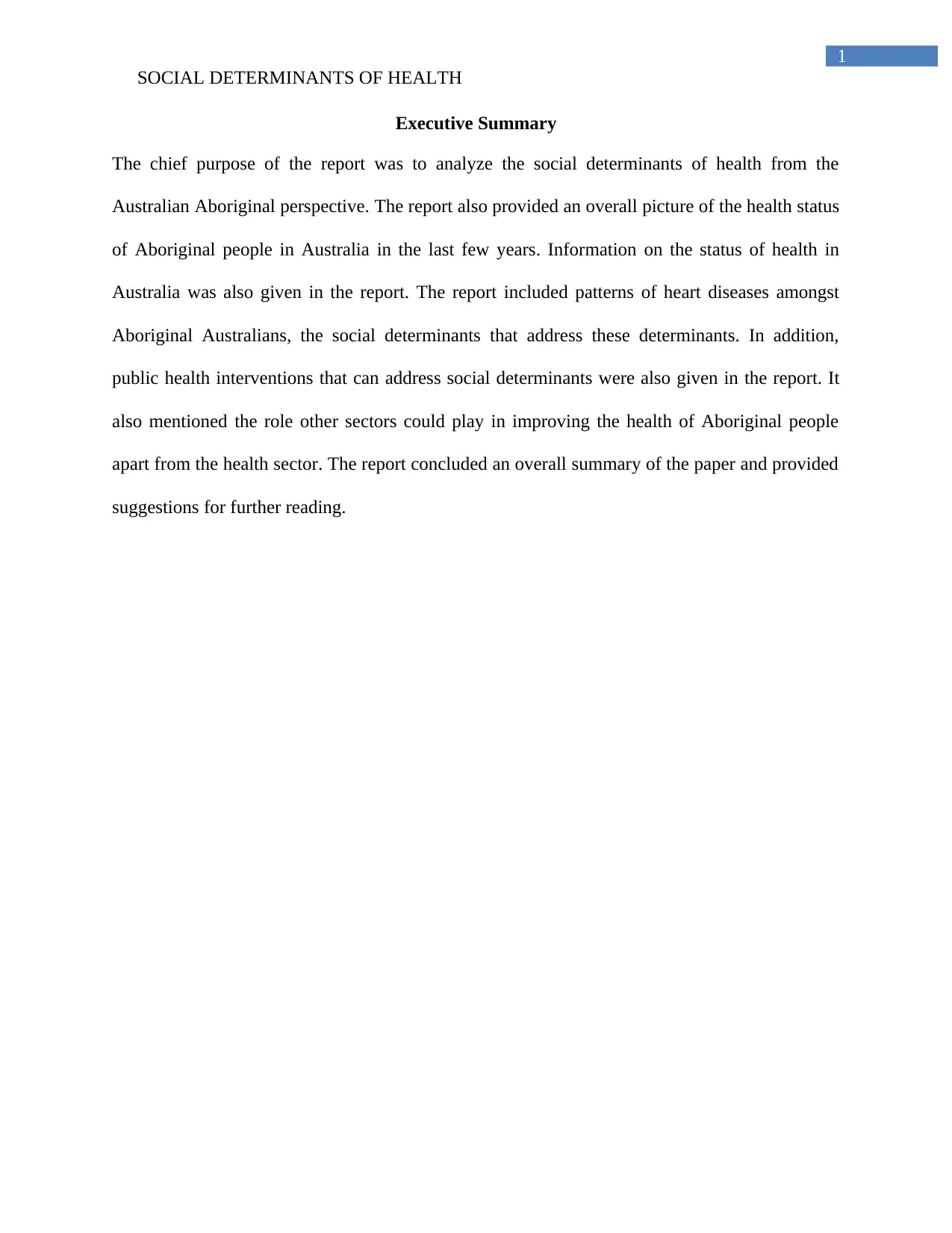
1
SOCIAL DETERMINANTS OF HEALTH
Executive Summary
The chief purpose of the report was to analyze the social determinants of health from the
Australian Aboriginal perspective. The report also provided an overall picture of the health status
of Aboriginal people in Australia in the last few years. Information on the status of health in
Australia was also given in the report. The report included patterns of heart diseases amongst
Aboriginal Australians, the social determinants that address these determinants. In addition,
public health interventions that can address social determinants were also given in the report. It
also mentioned the role other sectors could play in improving the health of Aboriginal people
apart from the health sector. The report concluded an overall summary of the paper and provided
suggestions for further reading.
SOCIAL DETERMINANTS OF HEALTH
Executive Summary
The chief purpose of the report was to analyze the social determinants of health from the
Australian Aboriginal perspective. The report also provided an overall picture of the health status
of Aboriginal people in Australia in the last few years. Information on the status of health in
Australia was also given in the report. The report included patterns of heart diseases amongst
Aboriginal Australians, the social determinants that address these determinants. In addition,
public health interventions that can address social determinants were also given in the report. It
also mentioned the role other sectors could play in improving the health of Aboriginal people
apart from the health sector. The report concluded an overall summary of the paper and provided
suggestions for further reading.
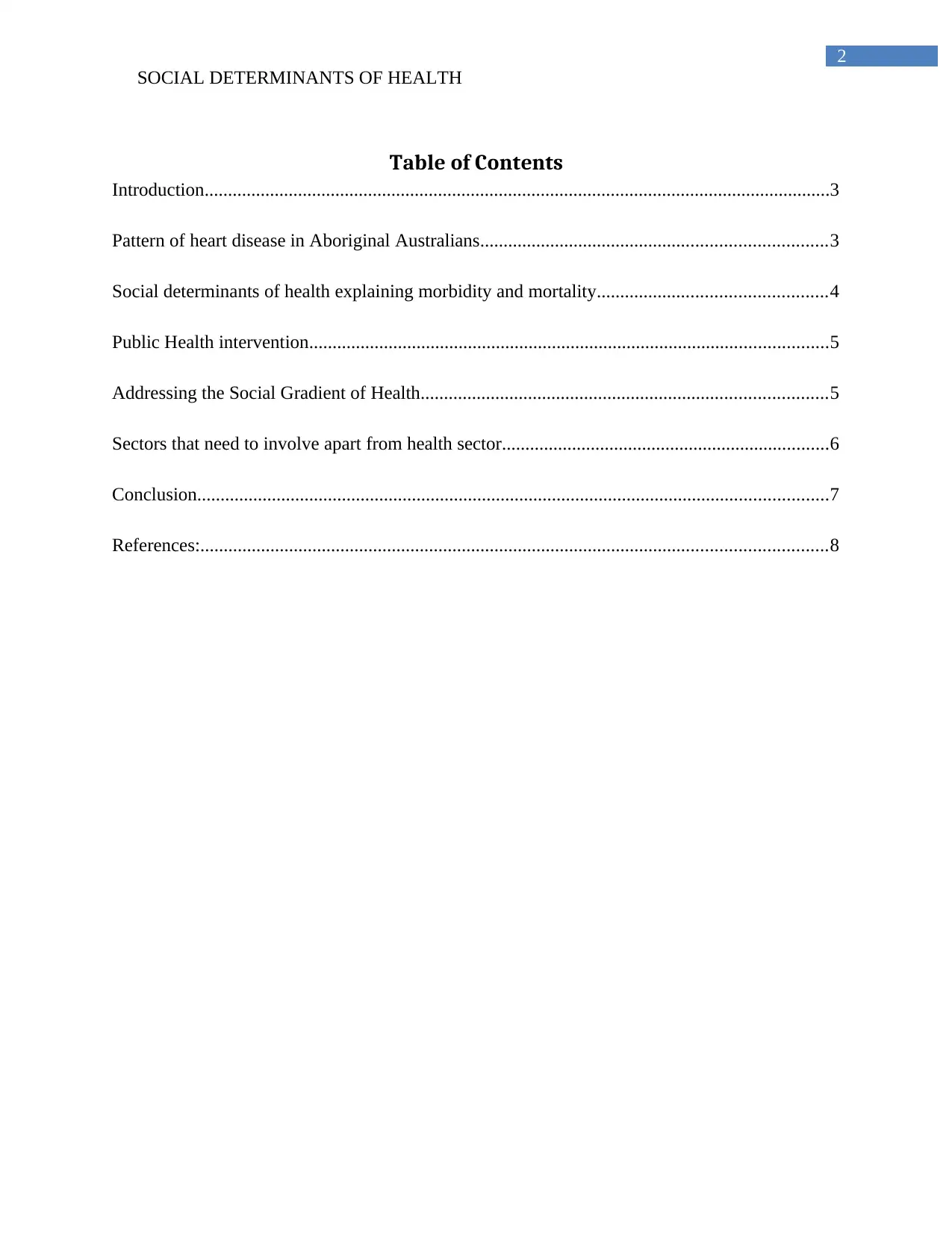
2
SOCIAL DETERMINANTS OF HEALTH
Table of Contents
Introduction......................................................................................................................................3
Pattern of heart disease in Aboriginal Australians..........................................................................3
Social determinants of health explaining morbidity and mortality.................................................4
Public Health intervention...............................................................................................................5
Addressing the Social Gradient of Health.......................................................................................5
Sectors that need to involve apart from health sector......................................................................6
Conclusion.......................................................................................................................................7
References:......................................................................................................................................8
SOCIAL DETERMINANTS OF HEALTH
Table of Contents
Introduction......................................................................................................................................3
Pattern of heart disease in Aboriginal Australians..........................................................................3
Social determinants of health explaining morbidity and mortality.................................................4
Public Health intervention...............................................................................................................5
Addressing the Social Gradient of Health.......................................................................................5
Sectors that need to involve apart from health sector......................................................................6
Conclusion.......................................................................................................................................7
References:......................................................................................................................................8
⊘ This is a preview!⊘
Do you want full access?
Subscribe today to unlock all pages.

Trusted by 1+ million students worldwide
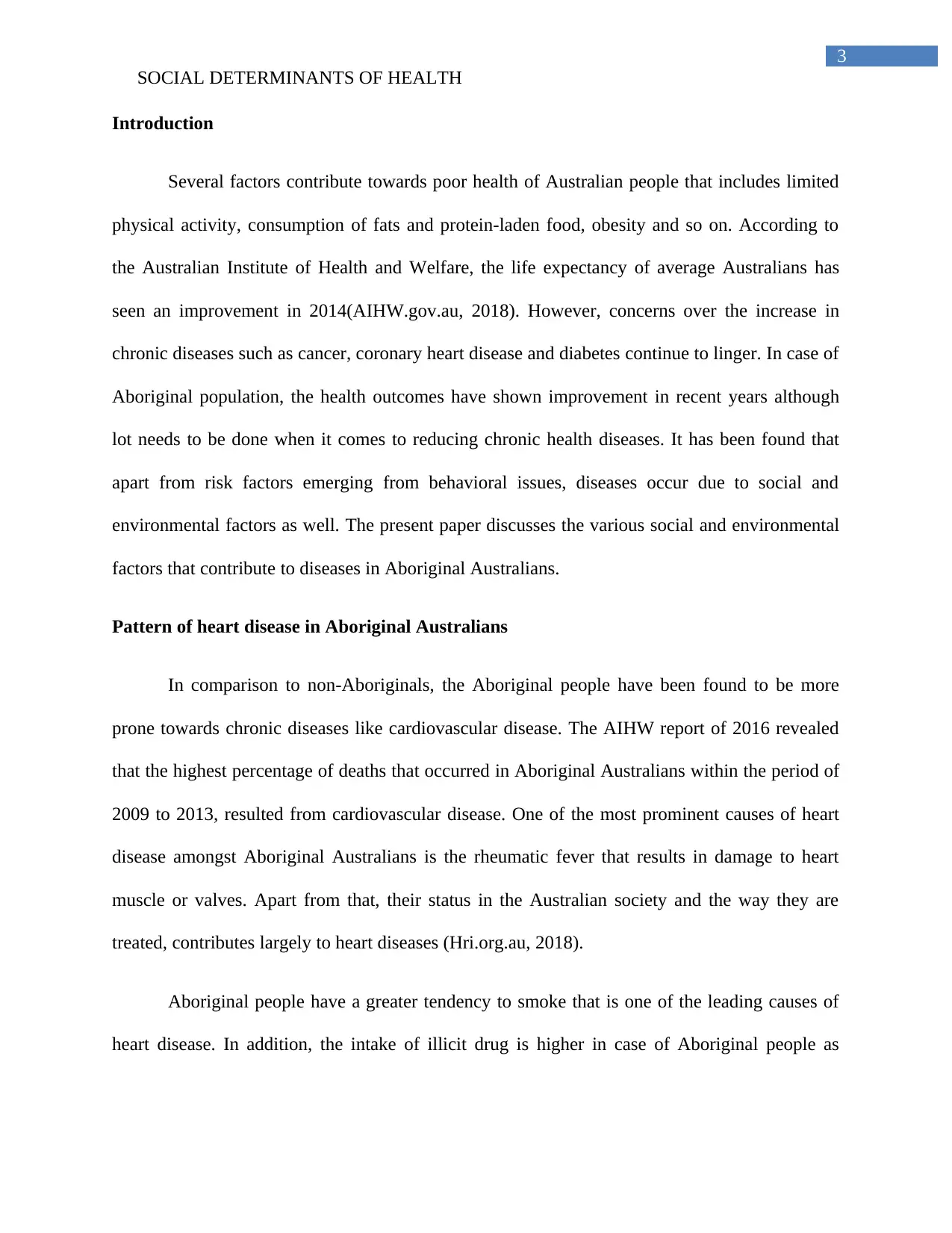
3
SOCIAL DETERMINANTS OF HEALTH
Introduction
Several factors contribute towards poor health of Australian people that includes limited
physical activity, consumption of fats and protein-laden food, obesity and so on. According to
the Australian Institute of Health and Welfare, the life expectancy of average Australians has
seen an improvement in 2014(AIHW.gov.au, 2018). However, concerns over the increase in
chronic diseases such as cancer, coronary heart disease and diabetes continue to linger. In case of
Aboriginal population, the health outcomes have shown improvement in recent years although
lot needs to be done when it comes to reducing chronic health diseases. It has been found that
apart from risk factors emerging from behavioral issues, diseases occur due to social and
environmental factors as well. The present paper discusses the various social and environmental
factors that contribute to diseases in Aboriginal Australians.
Pattern of heart disease in Aboriginal Australians
In comparison to non-Aboriginals, the Aboriginal people have been found to be more
prone towards chronic diseases like cardiovascular disease. The AIHW report of 2016 revealed
that the highest percentage of deaths that occurred in Aboriginal Australians within the period of
2009 to 2013, resulted from cardiovascular disease. One of the most prominent causes of heart
disease amongst Aboriginal Australians is the rheumatic fever that results in damage to heart
muscle or valves. Apart from that, their status in the Australian society and the way they are
treated, contributes largely to heart diseases (Hri.org.au, 2018).
Aboriginal people have a greater tendency to smoke that is one of the leading causes of
heart disease. In addition, the intake of illicit drug is higher in case of Aboriginal people as
SOCIAL DETERMINANTS OF HEALTH
Introduction
Several factors contribute towards poor health of Australian people that includes limited
physical activity, consumption of fats and protein-laden food, obesity and so on. According to
the Australian Institute of Health and Welfare, the life expectancy of average Australians has
seen an improvement in 2014(AIHW.gov.au, 2018). However, concerns over the increase in
chronic diseases such as cancer, coronary heart disease and diabetes continue to linger. In case of
Aboriginal population, the health outcomes have shown improvement in recent years although
lot needs to be done when it comes to reducing chronic health diseases. It has been found that
apart from risk factors emerging from behavioral issues, diseases occur due to social and
environmental factors as well. The present paper discusses the various social and environmental
factors that contribute to diseases in Aboriginal Australians.
Pattern of heart disease in Aboriginal Australians
In comparison to non-Aboriginals, the Aboriginal people have been found to be more
prone towards chronic diseases like cardiovascular disease. The AIHW report of 2016 revealed
that the highest percentage of deaths that occurred in Aboriginal Australians within the period of
2009 to 2013, resulted from cardiovascular disease. One of the most prominent causes of heart
disease amongst Aboriginal Australians is the rheumatic fever that results in damage to heart
muscle or valves. Apart from that, their status in the Australian society and the way they are
treated, contributes largely to heart diseases (Hri.org.au, 2018).
Aboriginal people have a greater tendency to smoke that is one of the leading causes of
heart disease. In addition, the intake of illicit drug is higher in case of Aboriginal people as
Paraphrase This Document
Need a fresh take? Get an instant paraphrase of this document with our AI Paraphraser
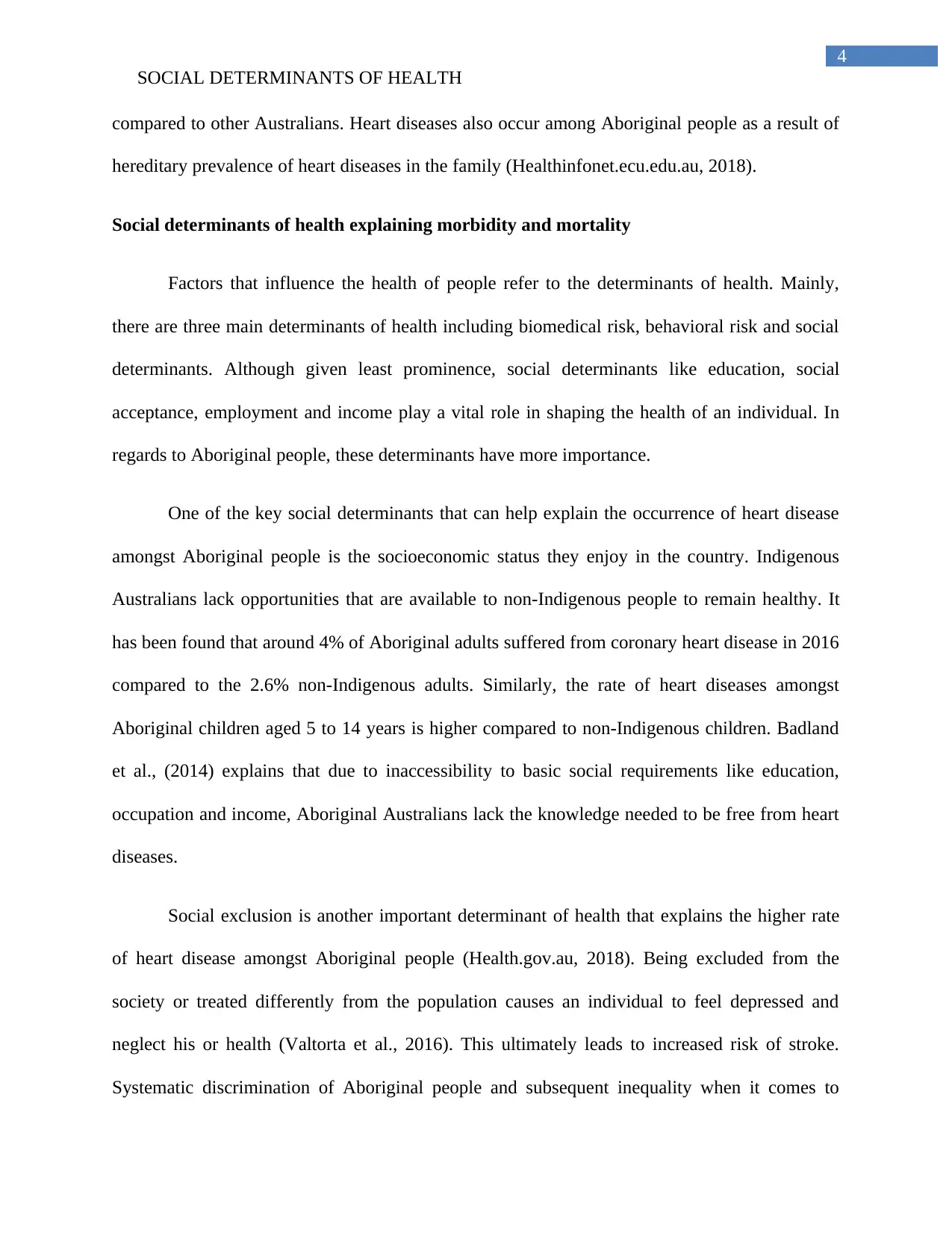
4
SOCIAL DETERMINANTS OF HEALTH
compared to other Australians. Heart diseases also occur among Aboriginal people as a result of
hereditary prevalence of heart diseases in the family (Healthinfonet.ecu.edu.au, 2018).
Social determinants of health explaining morbidity and mortality
Factors that influence the health of people refer to the determinants of health. Mainly,
there are three main determinants of health including biomedical risk, behavioral risk and social
determinants. Although given least prominence, social determinants like education, social
acceptance, employment and income play a vital role in shaping the health of an individual. In
regards to Aboriginal people, these determinants have more importance.
One of the key social determinants that can help explain the occurrence of heart disease
amongst Aboriginal people is the socioeconomic status they enjoy in the country. Indigenous
Australians lack opportunities that are available to non-Indigenous people to remain healthy. It
has been found that around 4% of Aboriginal adults suffered from coronary heart disease in 2016
compared to the 2.6% non-Indigenous adults. Similarly, the rate of heart diseases amongst
Aboriginal children aged 5 to 14 years is higher compared to non-Indigenous children. Badland
et al., (2014) explains that due to inaccessibility to basic social requirements like education,
occupation and income, Aboriginal Australians lack the knowledge needed to be free from heart
diseases.
Social exclusion is another important determinant of health that explains the higher rate
of heart disease amongst Aboriginal people (Health.gov.au, 2018). Being excluded from the
society or treated differently from the population causes an individual to feel depressed and
neglect his or health (Valtorta et al., 2016). This ultimately leads to increased risk of stroke.
Systematic discrimination of Aboriginal people and subsequent inequality when it comes to
SOCIAL DETERMINANTS OF HEALTH
compared to other Australians. Heart diseases also occur among Aboriginal people as a result of
hereditary prevalence of heart diseases in the family (Healthinfonet.ecu.edu.au, 2018).
Social determinants of health explaining morbidity and mortality
Factors that influence the health of people refer to the determinants of health. Mainly,
there are three main determinants of health including biomedical risk, behavioral risk and social
determinants. Although given least prominence, social determinants like education, social
acceptance, employment and income play a vital role in shaping the health of an individual. In
regards to Aboriginal people, these determinants have more importance.
One of the key social determinants that can help explain the occurrence of heart disease
amongst Aboriginal people is the socioeconomic status they enjoy in the country. Indigenous
Australians lack opportunities that are available to non-Indigenous people to remain healthy. It
has been found that around 4% of Aboriginal adults suffered from coronary heart disease in 2016
compared to the 2.6% non-Indigenous adults. Similarly, the rate of heart diseases amongst
Aboriginal children aged 5 to 14 years is higher compared to non-Indigenous children. Badland
et al., (2014) explains that due to inaccessibility to basic social requirements like education,
occupation and income, Aboriginal Australians lack the knowledge needed to be free from heart
diseases.
Social exclusion is another important determinant of health that explains the higher rate
of heart disease amongst Aboriginal people (Health.gov.au, 2018). Being excluded from the
society or treated differently from the population causes an individual to feel depressed and
neglect his or health (Valtorta et al., 2016). This ultimately leads to increased risk of stroke.
Systematic discrimination of Aboriginal people and subsequent inequality when it comes to
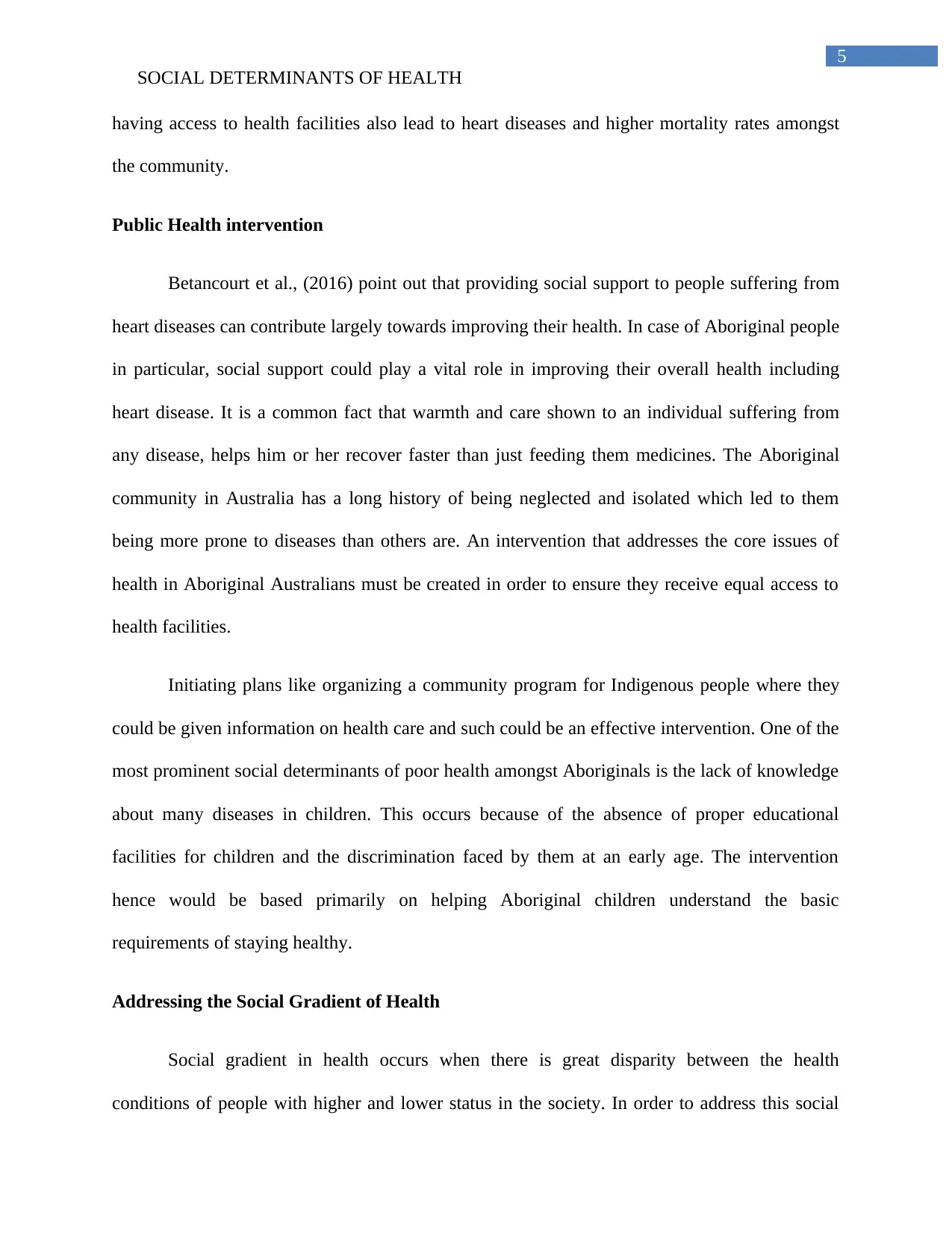
5
SOCIAL DETERMINANTS OF HEALTH
having access to health facilities also lead to heart diseases and higher mortality rates amongst
the community.
Public Health intervention
Betancourt et al., (2016) point out that providing social support to people suffering from
heart diseases can contribute largely towards improving their health. In case of Aboriginal people
in particular, social support could play a vital role in improving their overall health including
heart disease. It is a common fact that warmth and care shown to an individual suffering from
any disease, helps him or her recover faster than just feeding them medicines. The Aboriginal
community in Australia has a long history of being neglected and isolated which led to them
being more prone to diseases than others are. An intervention that addresses the core issues of
health in Aboriginal Australians must be created in order to ensure they receive equal access to
health facilities.
Initiating plans like organizing a community program for Indigenous people where they
could be given information on health care and such could be an effective intervention. One of the
most prominent social determinants of poor health amongst Aboriginals is the lack of knowledge
about many diseases in children. This occurs because of the absence of proper educational
facilities for children and the discrimination faced by them at an early age. The intervention
hence would be based primarily on helping Aboriginal children understand the basic
requirements of staying healthy.
Addressing the Social Gradient of Health
Social gradient in health occurs when there is great disparity between the health
conditions of people with higher and lower status in the society. In order to address this social
SOCIAL DETERMINANTS OF HEALTH
having access to health facilities also lead to heart diseases and higher mortality rates amongst
the community.
Public Health intervention
Betancourt et al., (2016) point out that providing social support to people suffering from
heart diseases can contribute largely towards improving their health. In case of Aboriginal people
in particular, social support could play a vital role in improving their overall health including
heart disease. It is a common fact that warmth and care shown to an individual suffering from
any disease, helps him or her recover faster than just feeding them medicines. The Aboriginal
community in Australia has a long history of being neglected and isolated which led to them
being more prone to diseases than others are. An intervention that addresses the core issues of
health in Aboriginal Australians must be created in order to ensure they receive equal access to
health facilities.
Initiating plans like organizing a community program for Indigenous people where they
could be given information on health care and such could be an effective intervention. One of the
most prominent social determinants of poor health amongst Aboriginals is the lack of knowledge
about many diseases in children. This occurs because of the absence of proper educational
facilities for children and the discrimination faced by them at an early age. The intervention
hence would be based primarily on helping Aboriginal children understand the basic
requirements of staying healthy.
Addressing the Social Gradient of Health
Social gradient in health occurs when there is great disparity between the health
conditions of people with higher and lower status in the society. In order to address this social
⊘ This is a preview!⊘
Do you want full access?
Subscribe today to unlock all pages.

Trusted by 1+ million students worldwide
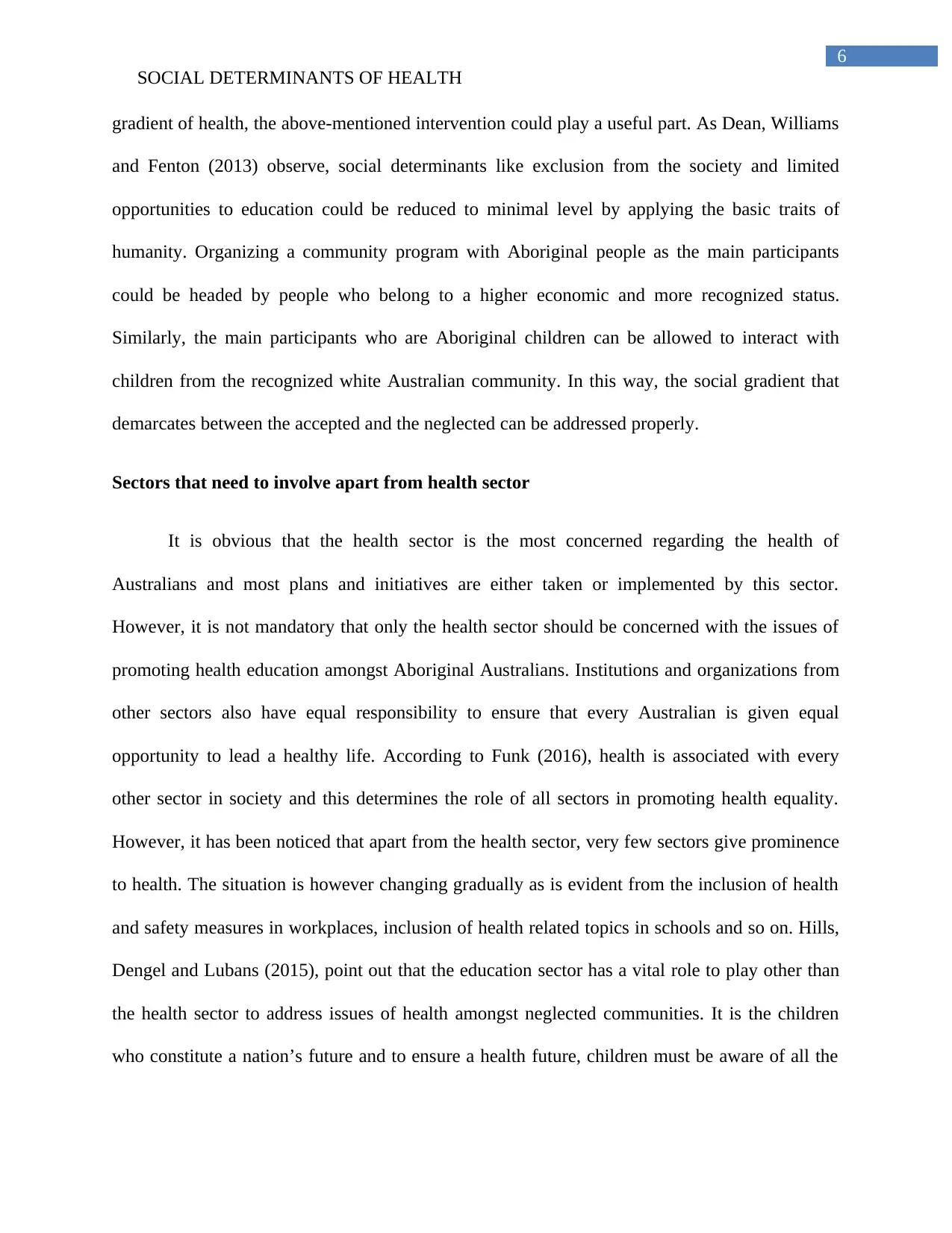
6
SOCIAL DETERMINANTS OF HEALTH
gradient of health, the above-mentioned intervention could play a useful part. As Dean, Williams
and Fenton (2013) observe, social determinants like exclusion from the society and limited
opportunities to education could be reduced to minimal level by applying the basic traits of
humanity. Organizing a community program with Aboriginal people as the main participants
could be headed by people who belong to a higher economic and more recognized status.
Similarly, the main participants who are Aboriginal children can be allowed to interact with
children from the recognized white Australian community. In this way, the social gradient that
demarcates between the accepted and the neglected can be addressed properly.
Sectors that need to involve apart from health sector
It is obvious that the health sector is the most concerned regarding the health of
Australians and most plans and initiatives are either taken or implemented by this sector.
However, it is not mandatory that only the health sector should be concerned with the issues of
promoting health education amongst Aboriginal Australians. Institutions and organizations from
other sectors also have equal responsibility to ensure that every Australian is given equal
opportunity to lead a healthy life. According to Funk (2016), health is associated with every
other sector in society and this determines the role of all sectors in promoting health equality.
However, it has been noticed that apart from the health sector, very few sectors give prominence
to health. The situation is however changing gradually as is evident from the inclusion of health
and safety measures in workplaces, inclusion of health related topics in schools and so on. Hills,
Dengel and Lubans (2015), point out that the education sector has a vital role to play other than
the health sector to address issues of health amongst neglected communities. It is the children
who constitute a nation’s future and to ensure a health future, children must be aware of all the
SOCIAL DETERMINANTS OF HEALTH
gradient of health, the above-mentioned intervention could play a useful part. As Dean, Williams
and Fenton (2013) observe, social determinants like exclusion from the society and limited
opportunities to education could be reduced to minimal level by applying the basic traits of
humanity. Organizing a community program with Aboriginal people as the main participants
could be headed by people who belong to a higher economic and more recognized status.
Similarly, the main participants who are Aboriginal children can be allowed to interact with
children from the recognized white Australian community. In this way, the social gradient that
demarcates between the accepted and the neglected can be addressed properly.
Sectors that need to involve apart from health sector
It is obvious that the health sector is the most concerned regarding the health of
Australians and most plans and initiatives are either taken or implemented by this sector.
However, it is not mandatory that only the health sector should be concerned with the issues of
promoting health education amongst Aboriginal Australians. Institutions and organizations from
other sectors also have equal responsibility to ensure that every Australian is given equal
opportunity to lead a healthy life. According to Funk (2016), health is associated with every
other sector in society and this determines the role of all sectors in promoting health equality.
However, it has been noticed that apart from the health sector, very few sectors give prominence
to health. The situation is however changing gradually as is evident from the inclusion of health
and safety measures in workplaces, inclusion of health related topics in schools and so on. Hills,
Dengel and Lubans (2015), point out that the education sector has a vital role to play other than
the health sector to address issues of health amongst neglected communities. It is the children
who constitute a nation’s future and to ensure a health future, children must be aware of all the
Paraphrase This Document
Need a fresh take? Get an instant paraphrase of this document with our AI Paraphraser
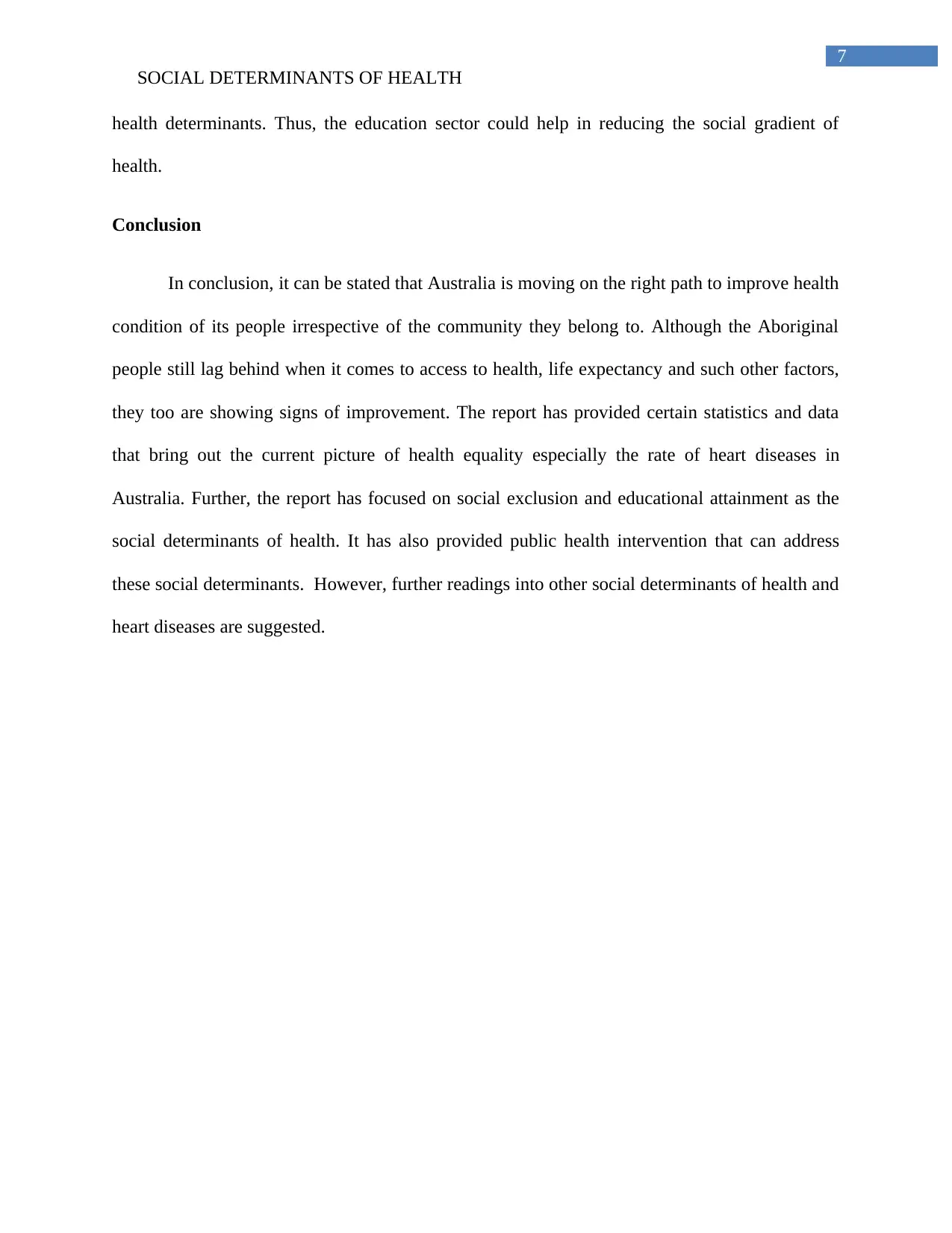
7
SOCIAL DETERMINANTS OF HEALTH
health determinants. Thus, the education sector could help in reducing the social gradient of
health.
Conclusion
In conclusion, it can be stated that Australia is moving on the right path to improve health
condition of its people irrespective of the community they belong to. Although the Aboriginal
people still lag behind when it comes to access to health, life expectancy and such other factors,
they too are showing signs of improvement. The report has provided certain statistics and data
that bring out the current picture of health equality especially the rate of heart diseases in
Australia. Further, the report has focused on social exclusion and educational attainment as the
social determinants of health. It has also provided public health intervention that can address
these social determinants. However, further readings into other social determinants of health and
heart diseases are suggested.
SOCIAL DETERMINANTS OF HEALTH
health determinants. Thus, the education sector could help in reducing the social gradient of
health.
Conclusion
In conclusion, it can be stated that Australia is moving on the right path to improve health
condition of its people irrespective of the community they belong to. Although the Aboriginal
people still lag behind when it comes to access to health, life expectancy and such other factors,
they too are showing signs of improvement. The report has provided certain statistics and data
that bring out the current picture of health equality especially the rate of heart diseases in
Australia. Further, the report has focused on social exclusion and educational attainment as the
social determinants of health. It has also provided public health intervention that can address
these social determinants. However, further readings into other social determinants of health and
heart diseases are suggested.
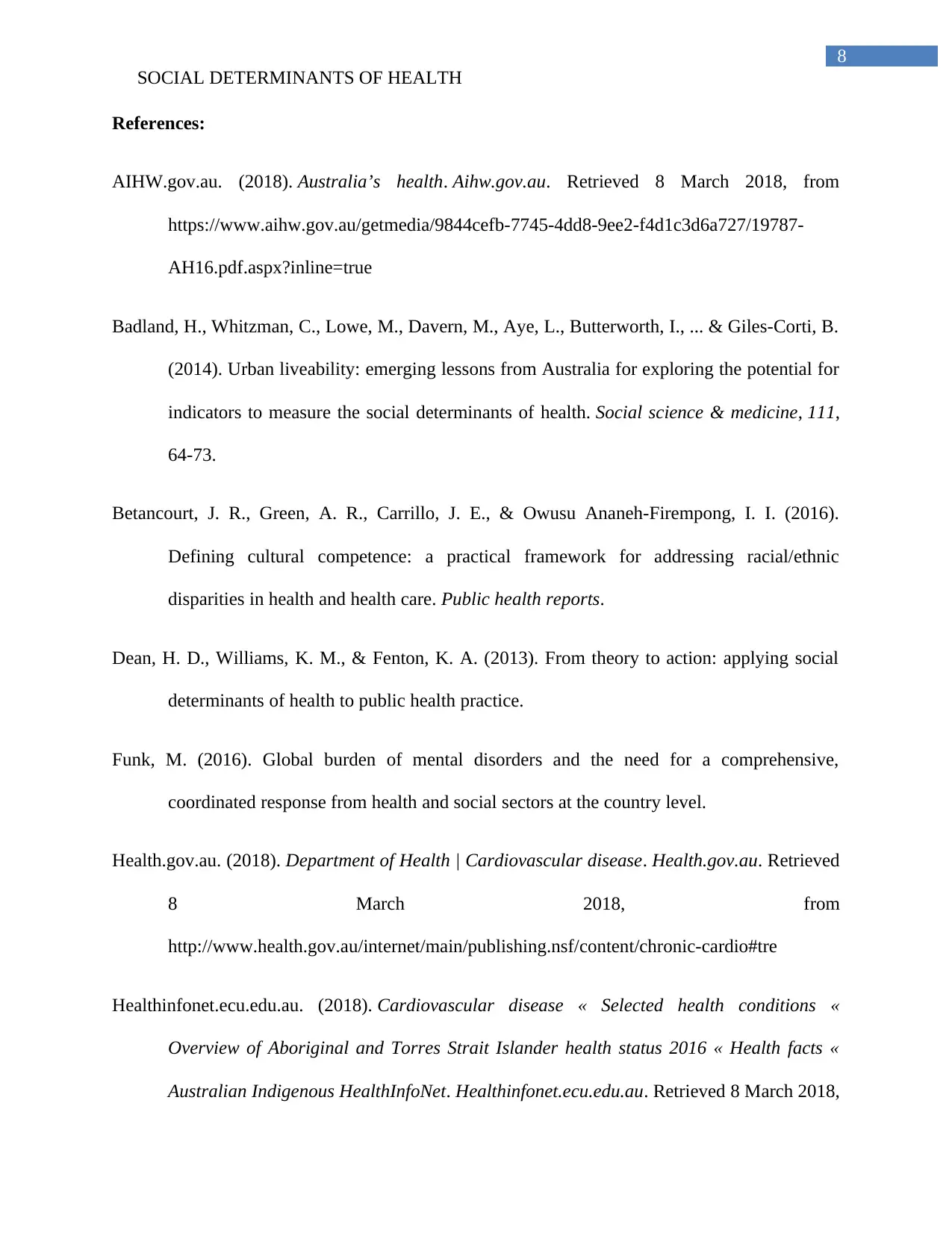
8
SOCIAL DETERMINANTS OF HEALTH
References:
AIHW.gov.au. (2018). Australia’s health. Aihw.gov.au. Retrieved 8 March 2018, from
https://www.aihw.gov.au/getmedia/9844cefb-7745-4dd8-9ee2-f4d1c3d6a727/19787-
AH16.pdf.aspx?inline=true
Badland, H., Whitzman, C., Lowe, M., Davern, M., Aye, L., Butterworth, I., ... & Giles-Corti, B.
(2014). Urban liveability: emerging lessons from Australia for exploring the potential for
indicators to measure the social determinants of health. Social science & medicine, 111,
64-73.
Betancourt, J. R., Green, A. R., Carrillo, J. E., & Owusu Ananeh-Firempong, I. I. (2016).
Defining cultural competence: a practical framework for addressing racial/ethnic
disparities in health and health care. Public health reports.
Dean, H. D., Williams, K. M., & Fenton, K. A. (2013). From theory to action: applying social
determinants of health to public health practice.
Funk, M. (2016). Global burden of mental disorders and the need for a comprehensive,
coordinated response from health and social sectors at the country level.
Health.gov.au. (2018). Department of Health | Cardiovascular disease. Health.gov.au. Retrieved
8 March 2018, from
http://www.health.gov.au/internet/main/publishing.nsf/content/chronic-cardio#tre
Healthinfonet.ecu.edu.au. (2018). Cardiovascular disease « Selected health conditions «
Overview of Aboriginal and Torres Strait Islander health status 2016 « Health facts «
Australian Indigenous HealthInfoNet. Healthinfonet.ecu.edu.au. Retrieved 8 March 2018,
SOCIAL DETERMINANTS OF HEALTH
References:
AIHW.gov.au. (2018). Australia’s health. Aihw.gov.au. Retrieved 8 March 2018, from
https://www.aihw.gov.au/getmedia/9844cefb-7745-4dd8-9ee2-f4d1c3d6a727/19787-
AH16.pdf.aspx?inline=true
Badland, H., Whitzman, C., Lowe, M., Davern, M., Aye, L., Butterworth, I., ... & Giles-Corti, B.
(2014). Urban liveability: emerging lessons from Australia for exploring the potential for
indicators to measure the social determinants of health. Social science & medicine, 111,
64-73.
Betancourt, J. R., Green, A. R., Carrillo, J. E., & Owusu Ananeh-Firempong, I. I. (2016).
Defining cultural competence: a practical framework for addressing racial/ethnic
disparities in health and health care. Public health reports.
Dean, H. D., Williams, K. M., & Fenton, K. A. (2013). From theory to action: applying social
determinants of health to public health practice.
Funk, M. (2016). Global burden of mental disorders and the need for a comprehensive,
coordinated response from health and social sectors at the country level.
Health.gov.au. (2018). Department of Health | Cardiovascular disease. Health.gov.au. Retrieved
8 March 2018, from
http://www.health.gov.au/internet/main/publishing.nsf/content/chronic-cardio#tre
Healthinfonet.ecu.edu.au. (2018). Cardiovascular disease « Selected health conditions «
Overview of Aboriginal and Torres Strait Islander health status 2016 « Health facts «
Australian Indigenous HealthInfoNet. Healthinfonet.ecu.edu.au. Retrieved 8 March 2018,
⊘ This is a preview!⊘
Do you want full access?
Subscribe today to unlock all pages.

Trusted by 1+ million students worldwide
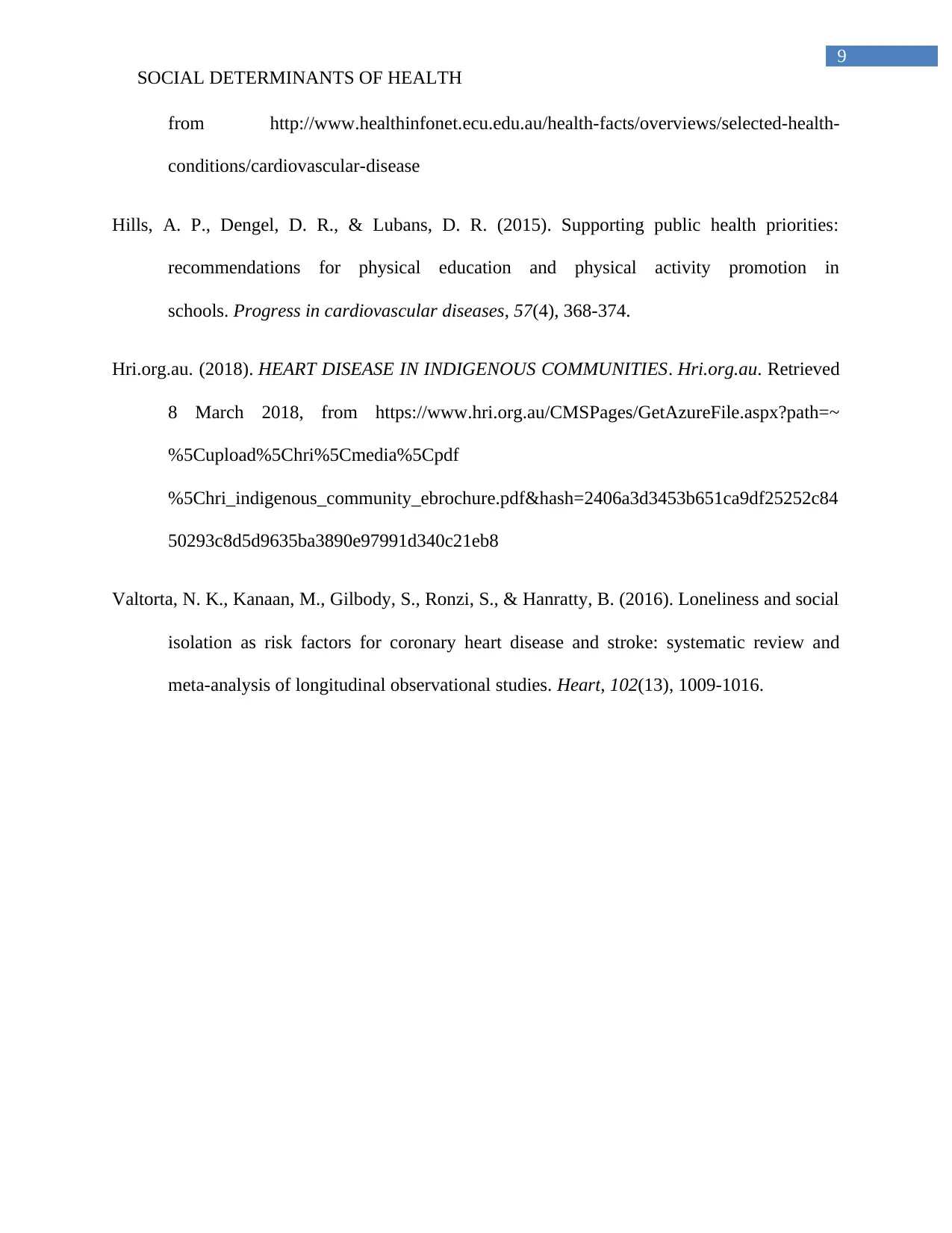
9
SOCIAL DETERMINANTS OF HEALTH
from http://www.healthinfonet.ecu.edu.au/health-facts/overviews/selected-health-
conditions/cardiovascular-disease
Hills, A. P., Dengel, D. R., & Lubans, D. R. (2015). Supporting public health priorities:
recommendations for physical education and physical activity promotion in
schools. Progress in cardiovascular diseases, 57(4), 368-374.
Hri.org.au. (2018). HEART DISEASE IN INDIGENOUS COMMUNITIES. Hri.org.au. Retrieved
8 March 2018, from https://www.hri.org.au/CMSPages/GetAzureFile.aspx?path=~
%5Cupload%5Chri%5Cmedia%5Cpdf
%5Chri_indigenous_community_ebrochure.pdf&hash=2406a3d3453b651ca9df25252c84
50293c8d5d9635ba3890e97991d340c21eb8
Valtorta, N. K., Kanaan, M., Gilbody, S., Ronzi, S., & Hanratty, B. (2016). Loneliness and social
isolation as risk factors for coronary heart disease and stroke: systematic review and
meta-analysis of longitudinal observational studies. Heart, 102(13), 1009-1016.
SOCIAL DETERMINANTS OF HEALTH
from http://www.healthinfonet.ecu.edu.au/health-facts/overviews/selected-health-
conditions/cardiovascular-disease
Hills, A. P., Dengel, D. R., & Lubans, D. R. (2015). Supporting public health priorities:
recommendations for physical education and physical activity promotion in
schools. Progress in cardiovascular diseases, 57(4), 368-374.
Hri.org.au. (2018). HEART DISEASE IN INDIGENOUS COMMUNITIES. Hri.org.au. Retrieved
8 March 2018, from https://www.hri.org.au/CMSPages/GetAzureFile.aspx?path=~
%5Cupload%5Chri%5Cmedia%5Cpdf
%5Chri_indigenous_community_ebrochure.pdf&hash=2406a3d3453b651ca9df25252c84
50293c8d5d9635ba3890e97991d340c21eb8
Valtorta, N. K., Kanaan, M., Gilbody, S., Ronzi, S., & Hanratty, B. (2016). Loneliness and social
isolation as risk factors for coronary heart disease and stroke: systematic review and
meta-analysis of longitudinal observational studies. Heart, 102(13), 1009-1016.
1 out of 10
Related Documents
Your All-in-One AI-Powered Toolkit for Academic Success.
+13062052269
info@desklib.com
Available 24*7 on WhatsApp / Email
![[object Object]](/_next/static/media/star-bottom.7253800d.svg)
Unlock your academic potential
Copyright © 2020–2025 A2Z Services. All Rights Reserved. Developed and managed by ZUCOL.





